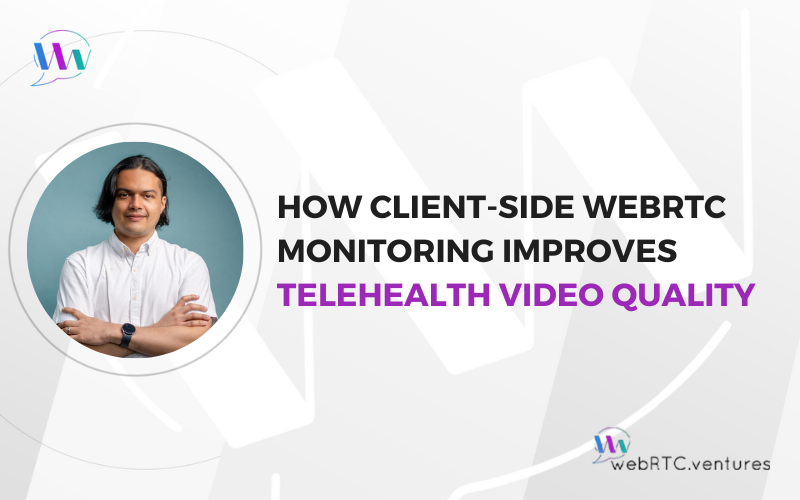WebRTC gave us real-time media for the Web — but it came with complexity, workarounds and tight coupling. In this episode, we explore Media over QUIC (MOQ), a protocol designed to deliver real-time media more simply, more flexibly and without the legacy overhead. We’ll dive into how MOQ works, how it compares to WebRTC under the hood and why it might be the future of streaming — especially for developers building collaborative, low-latency or async experiences.
Our guest is Ali C. Begen, a professor of computer science at Özyeğin University in Istanbul and founder of Networked Media, a consultancy focused on IP video technologies. A former technical lead at Cisco, Ali holds over 40 patents and has earned numerous honors including a Technology and Engineering Emmy® Award. He’s also a Fellow of the Streaming Video Technology Alliance and deeply involved in the development of Media over QUIC (MOQ).
Bonus Content
- Our regular monthly industry chat with Tsahi Levent-Levi. This month’s topic: AI in the WebRTC Marketplace. You can also watch this content on our YouTube channel.
Scroll down for key insights and episode highlights.
Watch Episode 102!
Key Insights
⚡ How did the Media over QUIC (MoQ) initiative begin? MoQ is gaining traction as a promising next step for real-time media delivery, especially in contexts where latency, reliability, and scalability matter.
Ali explains, “Media over QUIC is an effort that we started a bit over more than years now in the ITF, Internet Engineering Task Force, which is an open organization that builds all these different types of internet protocols. It could be TCP, UDP, QUIC, all the WebRTC protocols, and things like that. And QUIC has been standardized a while ago, and people have been contemplating about using QUIC for real-time media, not just for streaming media, which we’re already using for HTTP streaming. And there was a collective interest, and eventually there was a buff, and then that led to a working group.[…] About 15 to 20 people, so we tried to design all the protocols, details, stack, and everything and then hopefully we already have some implementations out there and hopefully it will be an RFC, probably not this year but hopefully next year but we will start seeing some deployments relatively soon.”
⚡ The real breakthrough for Media over QUIC will be relay support. As Media over QUIC continues to gain traction, one of its most transformative features may not be immediately obvious. It’s not just about reducing latency or unifying protocols, but about how it scales. Ali says, “I think the main win for Media over QUIC is going to be the relay support. So, on the top, we have all these different types of applications, as you can see, webcams, classroom teaching, presentations, drone security cameras, live sports chat, and anything like that. So they are so-called publishers, but they could also be the subscribers. If it is a two-way video conferencing or cloud gaming, it could be the subscriber as well. But I think the main development and infrastructure requirement, well, it’s not really infrastructure, it’s mostly software, so it’s going to be really CDN, mock CDN. It will be a set of relay nodes.”
⚡ MoQ unlocks more flexibility in real-time communication. Traditional real-time communication tools don’t offer playback flexibility. That’s exactly the problem MoQ aims to solve. Ali explains, “Right now, we are in a video conferencing application, and if somebody else just joined, they are not able to go back, rewind. On YouTube, they can do that. But on this application or on Zoom, you cannot do that. But with Media over QUIC, we will be able to do that because we have this that will allow you to grab things from the past. So you can subscribe to the current live point, but maybe you missed the question, or there was really some important information that you had to know before continuing with the rest of the conference. So you roll back, you listen to that part, and then you come back to the live edge. There is no way to do that in WebRTC unless you are really actually storing everything on the client side that will allow you to buffer.”
Episode Highlights
MOQ is a collaboration effort to unify media protocols.
Media over QUIC is being built as a collaborative effort to unify how we deliver media, real-time or streamed. Instead of solving one narrow problem, the goal is to create a single protocol that serves a wide range of use cases.
As Ali points out, “You might want to do something in a certain way, somebody else wants to do it in a different way. So we are trying to understand what are the pros and cons and trying to understand the trade-offs. So we are trying to do our best to please everybody and address all the use cases. And as we are talking about use cases, the primary use case for Media over QUIC was actually a relatively smaller portion of the entire media delivery spectrum. But I will show you a couple of slides where we over time came to conclusion that if you are going to go through all this hassle, why don’t we actually design a single protocol that might replace all the streaming protocols we have and all the real-time protocols we have today? And maybe a common single protocol will make life easier.”
Media over QUIC: one protocol to rule them all.
Could a single protocol handle both real-time communication and content streaming? According to Ali, that’s exactly the promise of MoQ. He explains, “We started to think, if we are going to do all this work, and if media over QUIC is so capable, why don’t we replace the entire spectrum with this? So yes, we have HLS for streaming, we have a BARTEC for near-real-time video. But if media over QUIC is meant to be latency tunable and configurable, and it is cacheable, and it works over the latest, greatest protocols, it is encrypted, secure, and all that, so why don’t we just use this? So the idea in this, why can’t we just unify real-time communications with content delivery? This is going to bring us a lot of advantages in practice. It’s going to lower the cost for CDN, service providers, content providers, and then with a single client framework, I can actually support all types of applications.”
Media over QUIC unbundles the complexity of WebRTC.
WebRTC was built for one-on-one video calls and meetings, but when scaled to larger, more complex scenarios like live events, it carries a lot of unnecessary baggage. That’s where MoQ comes in.
Ali explains, “If it is just two of us talking right now, and obviously people are watching us on YouTube or Twitter, which is the streaming part, it’s not the WebRTC part. But imagine that this conference that we have right now was over 100 people. It will be quite complicated. Who’s going to receive whose video, who’s going to multiplex, or is there going to be some sort of SFE or MCU somewhere in the middle? No, that’s going to do a lot of encoding, transcoding, or changing the codec vice versa, so Media over QUIC really wants to get rid of all those problems.“
Up Next! WebRTC Live Episode 103
Technical and UX Approaches for Integrating
Voice AI into WebRTC Apps
Wednesday, June 18 at 12:30 pm EDT











